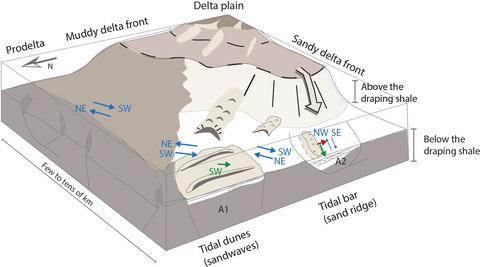当前位置:
X-MOL 学术
›
Basin Res.
›
论文详情
Our official English website, www.x-mol.net, welcomes your
feedback! (Note: you will need to create a separate account there.)
Architecture of growth basins in a tidally‐influenced, prodelta to delta‐front setting: the Triassic succession of Kvalpynten, East Svalbard
Basin Research ( IF 2.8 ) Pub Date : 2019-10-14 , DOI: 10.1111/bre.12410 Aleksandra Smyrak‐Sikora 1, 2 , Per Terje Osmundsen 3, 4 , Alvar Braathen 1, 4 , Kei Ogata 5 , Ingrid Anell 4 , Mark J. Mulrooney 4 , Valentin Zuchuat 4
Basin Research ( IF 2.8 ) Pub Date : 2019-10-14 , DOI: 10.1111/bre.12410 Aleksandra Smyrak‐Sikora 1, 2 , Per Terje Osmundsen 3, 4 , Alvar Braathen 1, 4 , Kei Ogata 5 , Ingrid Anell 4 , Mark J. Mulrooney 4 , Valentin Zuchuat 4
Affiliation

|
[Abstract World‐class examples of fault‐controlled growth basins with associated syn‐kinematic sedimentary fill are developed in Upper Triassic prodelta to delta‐front deposits exposed at Kvalpynten, SW Edgeoya in East Svalbard. They are interpreted to have interacted with north‐westerly progradation of a regional delta system. The syn‐kinematic successions consist of 4 to 5 coarsening‐upward units spanning from offshore mudstones to subtidal heterolithic bars and compound tidal dunes, which were blanketed by regional, post‐kinematic sandstone sheets deposited as laterally continuous, subaqueous tidal dune fields. The rate of growth faulting is reflected in the distribution of accommodation, which governs sedimentary architecture and stacking patterns within the coarsening‐upward units. Fully compartmentalized basins (12, 200–800 m wide and c. 150 m high grabens and half grabens) are characterized by syn‐kinematic sedimentary infill. These grabens and half‐grabens are separated by 60–150 m high horsts composed of pro‐delta to distal delta‐front mudstones. Grabens host tabular tidal dunes (sandwaves), whereas half‐grabens bound by listric faults (mainly south‐dipping) consist of wedge‐shaped, rotated strata with erosive boundaries proximal to the uplifted fault block crests. Heterolithic tidal bars (sand ridges) occur in narrow half‐grabens, showing migration oblique to the faults, up the dipslope. Structureless sandstone wedges and localized subaqueous slumps that formed in response to collapse of the block crests were only documented in half‐grabens. Late‐kinematic deposition during the final stages of faulting occurred in partly compartmentalized basins, filled with variably thick sets of continuous sandstone belts (compound tidal dunes)., Conceptual model of growth basins and their development in prodelta/ lower front of a tidally influenced delta. Heterolithic and sand deposits are redistributed by tidal bars and dunes, detached from the delta‐ front/ delta top. ]
中文翻译:

受潮汐影响的前三角洲到三角洲前缘环境中生长盆地的结构:东斯瓦尔巴群岛 Kvalpynten 的三叠纪序列
[摘要 在上三叠统前三角洲至三角洲前缘沉积物中开发了断层控制生长盆地的世界级实例,这些盆地与东斯瓦尔巴群岛的 SW Edgeoya 出露。它们被解释为与区域三角洲系统的西北进积相互作用。同动力层序由 4 到 5 个向上粗化的单元组成,从近海泥岩到潮下异岩坝和复合潮汐沙丘,被区域性的后运动砂岩片覆盖,沉积为横向连续的水下潮汐沙丘场。生长断层的速度反映在容纳分布上,它控制着向上粗化单元内的沉积结构和堆积模式。完全分隔的盆地(12, 200-800 m 宽,c. 150 m 高的地堑和半地堑)具有同运动沉积充填特征。这些地堑和半地堑被由前三角洲至远三角洲前缘泥岩组成的 60-150 m 高地垒隔开。地堑拥有板状潮汐沙丘(沙波),而由李斯特断层(主要是南倾)包围的半地堑由楔形旋转地层组成,侵蚀边界靠近抬升的断块波峰。异石潮汐坝(沙脊)出现在狭窄的半地堑中,显示向断层倾斜,向上倾斜。无结构的砂岩楔形和局部水下塌陷是由于块体顶部坍塌而形成的,仅在半地堑中记录。断层最后阶段的晚期运动沉积发生在部分分隔的盆地中,充满不同厚度的连续砂岩带(复合潮汐沙丘)。生长盆地的概念模型及其在受潮汐影响的三角洲前三角洲/下前缘的发育。异石和砂沉积物被潮汐坝和沙丘重新分布,与三角洲前缘/三角洲顶部分离。]
更新日期:2019-10-14
中文翻译:

受潮汐影响的前三角洲到三角洲前缘环境中生长盆地的结构:东斯瓦尔巴群岛 Kvalpynten 的三叠纪序列
[摘要 在上三叠统前三角洲至三角洲前缘沉积物中开发了断层控制生长盆地的世界级实例,这些盆地与东斯瓦尔巴群岛的 SW Edgeoya 出露。它们被解释为与区域三角洲系统的西北进积相互作用。同动力层序由 4 到 5 个向上粗化的单元组成,从近海泥岩到潮下异岩坝和复合潮汐沙丘,被区域性的后运动砂岩片覆盖,沉积为横向连续的水下潮汐沙丘场。生长断层的速度反映在容纳分布上,它控制着向上粗化单元内的沉积结构和堆积模式。完全分隔的盆地(12, 200-800 m 宽,c. 150 m 高的地堑和半地堑)具有同运动沉积充填特征。这些地堑和半地堑被由前三角洲至远三角洲前缘泥岩组成的 60-150 m 高地垒隔开。地堑拥有板状潮汐沙丘(沙波),而由李斯特断层(主要是南倾)包围的半地堑由楔形旋转地层组成,侵蚀边界靠近抬升的断块波峰。异石潮汐坝(沙脊)出现在狭窄的半地堑中,显示向断层倾斜,向上倾斜。无结构的砂岩楔形和局部水下塌陷是由于块体顶部坍塌而形成的,仅在半地堑中记录。断层最后阶段的晚期运动沉积发生在部分分隔的盆地中,充满不同厚度的连续砂岩带(复合潮汐沙丘)。生长盆地的概念模型及其在受潮汐影响的三角洲前三角洲/下前缘的发育。异石和砂沉积物被潮汐坝和沙丘重新分布,与三角洲前缘/三角洲顶部分离。]











































 京公网安备 11010802027423号
京公网安备 11010802027423号